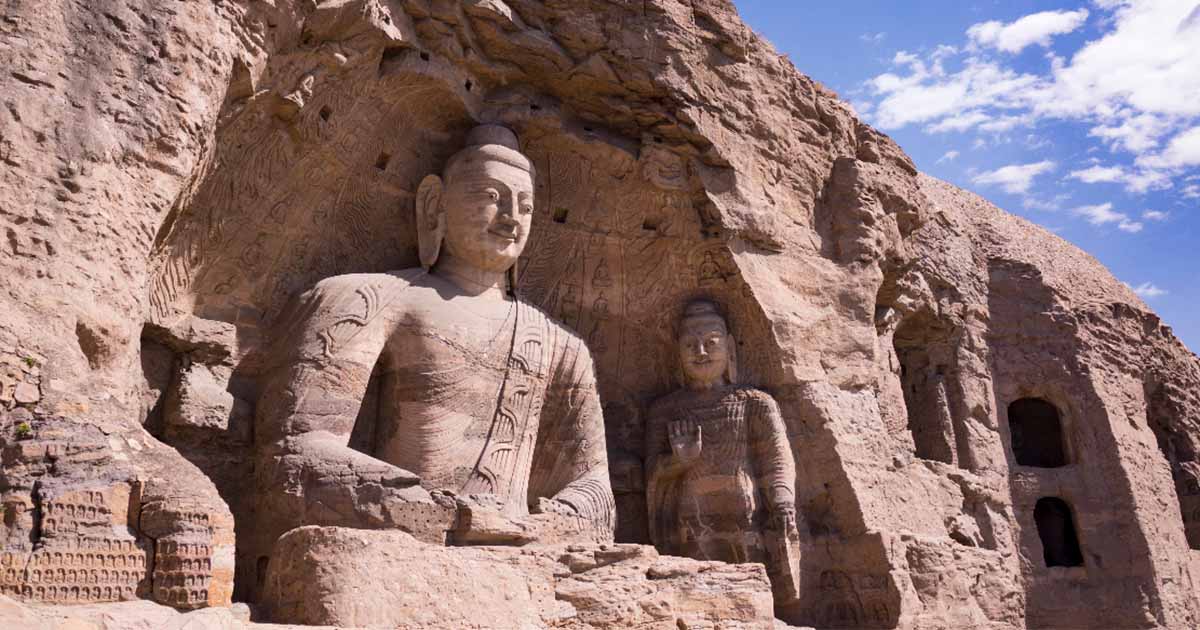The Magnificent Yungang Grottoes Are a Testament of China’s Buddhist History
The history of Ancient China is full of different ethnicities, cultures, and religions. But Buddhism in China has deep and far-reaching roots. Throughout the centuries, it has left many famous and recognizable landmarks all across China. Amongst the foremost of these landmarks are the Yungang Grottoes, a set of ancient Buddhist temple grottoes that are so enchanting and so awe-inspiring, that they simply defy all sense of logic. How were they constructed? And by whom? Let’s find out.
Yungang Grottoes and the History of Buddhist China
The Yungang Grottoes, also known as the Wuzhoushan Grottoes, are a UNESCO World Heritage site located near the city of Datong in Shanxi Province, China. They are one of the most renowned ancient Buddhist temple grotto complexes in China and are considered a masterpiece of early Chinese Buddhist cave art.

A panoramic view of the Yungang Grottoes from Northern Wei Dynasty in Datong, China. (Charlie fong/CC BY-SA 4.0)
The construction of the Yungang Grottoes began in the year 460 during the Northern Wei Dynasty (386-534 AD), and was initiated by Emperor Xiaowen. The Northern Wei Dynasty was a period of political and cultural transition in northern China when Buddhism was adopted as the state religion. This widespread religion arrived into the region through the famed Silk Road, which was used as an ancient interstate, through which cultural influences were exchanged. Emperor Xiaowen sought to establish Buddhism as a unifying force among his multiethnic empire and used the construction of the grottoes as a means to demonstrate imperial power and promote Buddhist teachings. The construction continued for about 50 years and involved thousands of artisans and craftsmen.
The grottoes were carved into the southern face of Wuzhou Mountain and extend over a distance of about one kilometer. They were the result of the collective efforts of numerous artists, craftsmen, and skilled workers. The primary sculptor responsible for the initial phase of construction was a monk named Tan Yao, who was assisted by a team of artisans and laborers. The exact identities of these individuals have largely been lost to history, but their contributions left an indelible mark on the grottoes' artistry. There are 53 major caves, along with 51,100 niches and the same number of intricate Buddha statues. Besides this, there are another 1,100 additional caves which are considered to be minor. The caves vary in size, with the largest reaching a height of 20 meters (65.62 ft) The sculptures are made of stone and depict a wide range of Buddhist deities, bodhisattvas, and scenes from Buddhist scriptures.
- One in 8,000! This Unique Terracotta Figure Is Unlike All The Rest
- The Leshan Giant Buddha: Largest Stone Buddha in the World
A Masterpiece of Ancient Rock Art
The Yungang Grottoes showcase a fusion of Indian Gandhara art, which arrived via the Silk Road, and local Chinese artistic traditions. The sculptures demonstrate a high level of craftsmanship and artistry, characterized by intricate details, expressive features, and dynamic poses. Furthermore, these grottoes represent an important period in the development of Buddhist art in China and hold significant cultural and historical value. They provide insights into the spread of Buddhism in this region of Asia, and the cultural exchanges between different civilizations along the Silk Road.

Close up of one of the larger Buddha statues at Yungang. (Felix Andrews (Floybix)/CC BY-SA 3.0)
Throughout history, the Yungang Grottoes served as an important center for Buddhist worship, meditation, and religious ceremonies. The caves were seen as sacred spaces where believers could connect with the divine and seek spiritual enlightenment. The statues and intricate carvings depicted various Buddhist deities, bodhisattvas, and scenes from Buddhist scriptures, conveying the teachings and ideals of Buddhism to both monks and laypeople. Furthermore, they exerted a significant influence on subsequent Buddhist art and cave construction in China. The unique artistic style of the grottoes became a foundation for later cave temples and sculptures across the country. Their artistic and architectural achievements had a lasting impact on the development of Buddhist art and cultural exchanges along the Silk Road.

Beautiful Buddhist art inside cave 11, Yungang Grottoes. (trialartinf/Adobe Stock)
Over the centuries, the Yungang Grottoes - sadly - faced natural deterioration, weathering, and human-related damage. During the Qing Dynasty (1644-1912), the grottoes were “rediscovered” by scholars and explorers, who recognized their historical and artistic significance. In the modern era, extensive preservation and restoration efforts have been undertaken to protect the grottoes. The site has been equipped with protective measures, such as rock shelters and visitor management systems, to safeguard the sculptures from further degradation.
- The mummified monk inside a Buddha statue
- Could There be a Third Bamiyan Buddha, Hidden for Centuries?
An Important Piece of Chinese Heritage
The Yungang Grottoes were inscribed as a UNESCO World Heritage site in 2001. They are recognized for their outstanding universal value, cultural significance, and artistic excellence. One glimpse at these wondrous ancient sculptures - in their thousands - can quickly tell you that their significance is incredible. They won’t fail to leave you speechless.
Visiting the Yungang Grottoes allows anyone to appreciate the rich Buddhist heritage of China, marvel at the intricate sculptures, and witness the historical and artistic accomplishments of the Northern Wei Dynasty. They stand as a testament to the religious devotion, artistic prowess, and cultural exchange of ancient China. And most importantly, they continue to inspire awe and admiration through their historical, artistic, and spiritual value.
Top image: The Yungang Grottoes are a UNESCO World heritage site in Datong, Shanxi province, China. Source: mijun/Adobe Stock
References
Caswell, J. O. 1988. Written and Unwritten: A New History of the Buddhist Caves at Yungang. University of British Columbia Press.
Salmon, L. G. Protecting the Yungang Grottoes from Air Pollution Damage. Available at:
http://www.thesalmons.org/lynn/chinawork.html
Unknown. 2015. Yungang Caves. Britannica.

















